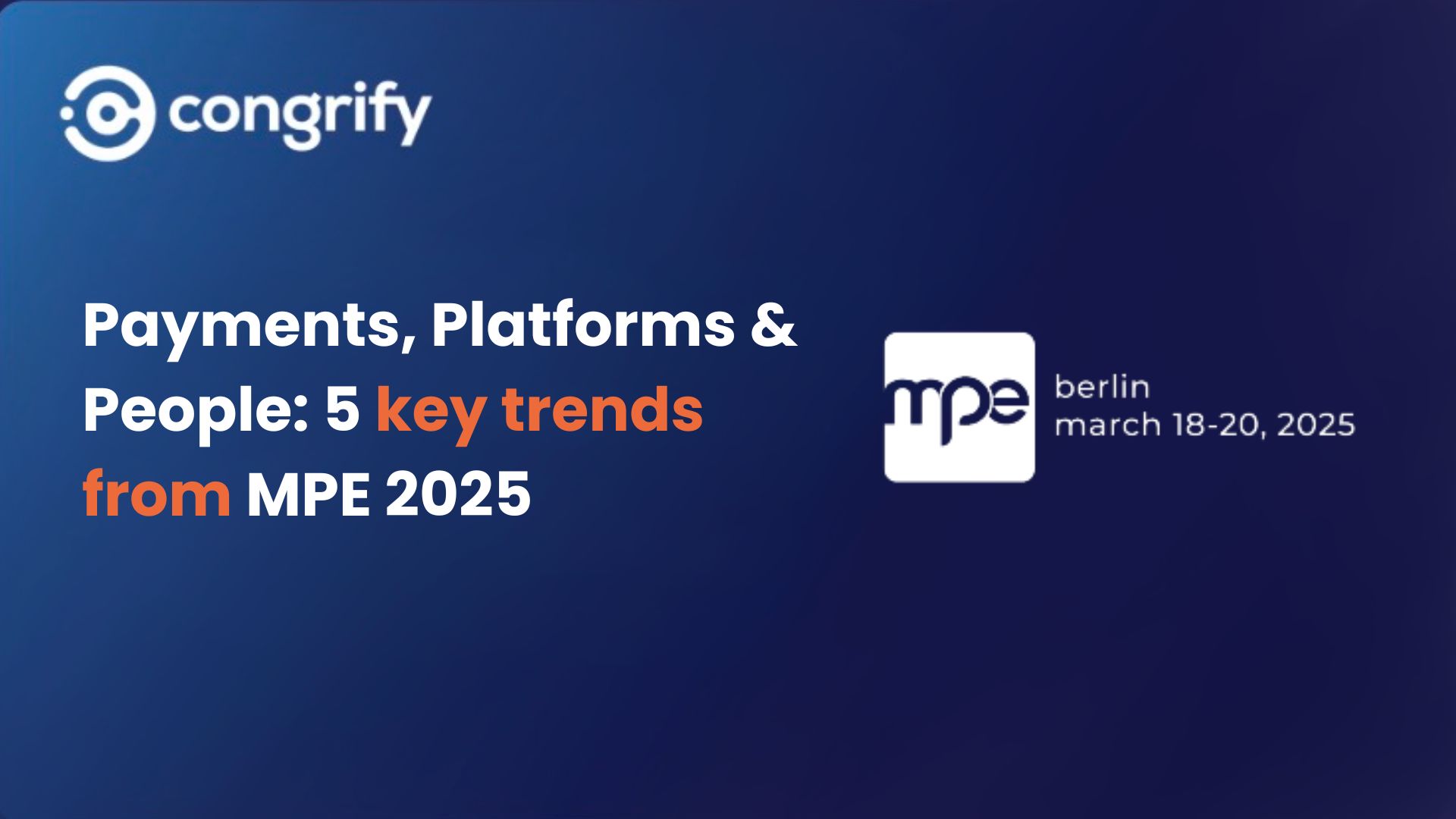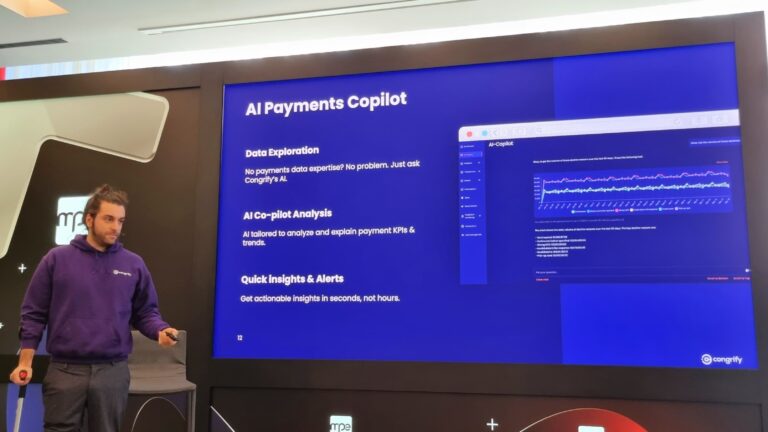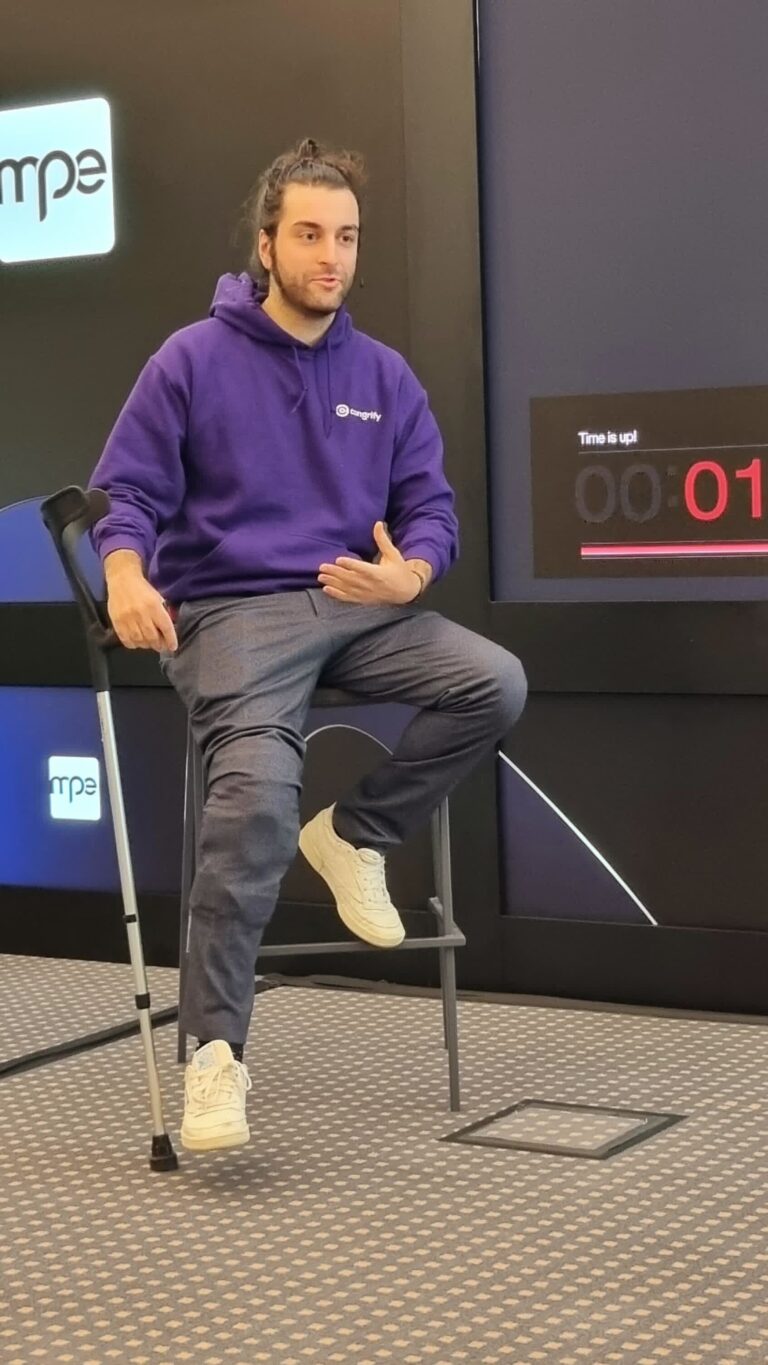Payments, Platforms & People: 5 Key Trends from MPE 2025

Congrify shares key insights from MPE 2025 in Berlin – exploring the top payment trends shaping the future.
By Rihab Oudda
As every year, Congrify joined the Merchant Payments Ecosystem (MPE) in Berlin — the leading conference for payment professionals across Europe and beyond. This year, it was a bit more special. Our CEO, Marco Conte, not only attended but also presented at the Innovation Stage for startups — just three weeks after knee surgery (yes, really 👏). We shared the spotlight with several exciting startups working with data intelligence like Torus, Zero Risk, and Optimus Fintech, highlighting the growing momentum in payment intelligence.
Here’s our recap of the 5 key trends that caught our attention at MPE 2025.
1. AI Is Moving Beyond Fraud Prevention
AI in payments isn’t new — but its applications are rapidly expanding. Traditionally focused on fraud prevention and chargeback management, AI has helped merchants navigate complex compliance frameworks enforced by card schemes like Visa and Mastercard. In fact, we recently broke down those very programs in our blog post on costs in payments — including dispute monitoring thresholds, excessive chargeback programs, and fraud activity flags that can trigger major penalties if not properly managed. But at MPE 2025, the conversation evolved.
Merchants are no longer just trying to accept payments securely — they’re trying to operate smarter and more efficiently.
There’s a growing interest in using AI to handle everyday payment operations, including:
Dispute and Chargeback Resolution
This remains one of the most manual and time-consuming pain points in the industry. Most merchants are still relying on heavily manual or only semi-automated processes to manage disputes — from tracking down receipts to assembling evidence and submitting responses within tight timelines. With AI agents, there’s now the possibility to automatically collect data points across scattered systems and recommend the best dispute strategy or even act on the merchant’s behalf. This shift not only saves time but also increases win rates and reduces lost revenue from preventable chargebacks.
Transaction Reconciliation
This is a big pain in the industry — and one that eats up internal resources fast. Teams spend hours trying to match payment records, bank statements, processor reports, and accounting systems — all while juggling different file formats, currencies, and cut-off times. Now, there’s a growing push to delegate this process to specialized solutions that offer advanced reconciliation workflows, often through no-code or low-code integrations that can be tailored to a merchant’s setup.
Fee Optimization and Anomaly Detection
Understanding and allocating payment fees is no easy task. With different processors, methods, schemes, and regions all charging in different ways — tracking and managing payment costs often becomes a tedious, error-prone process. AI is now being used to analyze historical transaction data, allocate fees more accurately, and flag anomalies in cost structures — such as unexpected spikes or misaligned fee applications. This saves time, reduces manual errors, and unlocks deeper insights — especially when powered by clean, accessible data.
Our no-code solution helps merchants and platforms to leverage AI for many of those topics, with dedicated Machine Learning models tailored to specific needs and AI Agents that can support companies in achieve extended levels of automation.
2. Payments Are Everyone’s Business
We have seen many people not having the traditional Payment Manager or Head of Payment roles coming to this event. For the first time we see as well people with data, engineering and more different product roles taking part, indicating that more people are involved as payments is taking more attention in many companies.
Payments are becoming a strategic function, which is seen not only as a cost but rather as a revenue driver.
Payments is a complex industry with many different stakeholders or approaches, that’s why having knowledge and staying up to date has become key for many companies. Events such as MPE in Berlin can play a vital role in sharing knowledge and first-hand experiences between industry peers, considering very tailored formats that were intoduced such as topic specific roundtables beside different dedicated sessions for the most relevant topics in the industry.
3. Europe Is Searching for Its Own Rails
One of the hottest discussion points at MPE 2025? Alternative payment rails — and whether Europe is finally ready to move away from its heavy dependence on Visa, Mastercard, and PayPal. In countries like Germany, PayPal alone makes up nearly 50% of merchant payment volume. And while card networks still dominate globally, the conversation is shifting: can Europe build something of its own that’s scalable, cost-effective, and widely adopted? Open Banking providers like Volt.io, Yapily, and Truelayer, along with Wero (formerly EPI), have been around for a while, promising a real-time, account-to-account future. But despite solid infrastructure and increasing regulatory support, mainstream adoption hasn’t followed.
Is it just slow adoption? A UX problem? Or a bigger sign that the market isn’t quite ready?
The potential is real. A2A payments can slash transaction costs — from dollars to just a few cents — and remove several intermediaries from the process. That’s a major opportunity for merchants looking to improve margins, particularly in high-volume or low-ticket categories. With fewer layers involved, there’s also the promise of faster settlement, fewer chargebacks, and better transparency. But the key challenge isn’t just technical — it’s behavioral. Widespread change requires merchants to rethink their checkout flow and consumers to shift their habits. And that takes time, education, and a frictionless experience.
Still, the vibe at MPE was clear: Europe wants alternatives, and the appetite for change is growing. Whether that appetite turns into action will depend on how well these solutions can deliver not just on infrastructure — but on trust, convenience, and consistency.
A payment revolution may be brewing… but the real question is: who’s going to lead it?
4. Data is Still King — But Also the Kingdom
“Data is king” is more than a cliché — it’s the biggest enabler (or blocker) of innovation in payments today. Many merchants are still struggling with:
- Fragmented data spread across multiple payment service providers, acquirers, payments methods and internal data sources.
- Siloed reporting systems that make it hard to compare performance across channels or providers where different teams have access to different sub datasets.
- The lack of comprehensive tools and business intelligence solutions that address all needs without requiring manual investigation of edge cases or direct access to original data sources significantly prolongs the analysis process.
- Within the same company, there is often no single source of truth for reconciliation, dispute resolution, cost analysis, or performance management, as different teams rely on separate datasets that are not integrated.
As a result, even the most well-intentioned teams find themselves stuck making decisions based on partial information, spending hours manually consolidating spreadsheets, encountering reporting inconsistencies across systems, and missing opportunities to optimize routes, reduce fees, or detect anomalies early. And perhaps most importantly:
AI doesn’t work without good data.
You can’t build strong models or make accurate predictions if the input is incomplete, messy, or delayed.
At MPE, there was a clear call to action:
Unlocking full payment intelligence means simplifying how data is accessed, cleaned, and visualized — without requiring technical teams every step of the way.
With Congrify Co-Pilot payments assistant, companies can now have a “ChatGPT for payments” without any implementation and integration efforts.
5. Everyone Wants to Be a Fintech
Everyone seems to want to be a fintech — or at least, act like one. From marketplaces to platforms, companies are exploring embedded finance, merchant of record models, card issuing possibilities— looking to turn payments from a pure cost center into a new revenue stream generator. But this isn’t without its challenges. Integrating new payment capabilities brings different new challenges such as:
- Building deep payments expertise within teams to effectively design and position enhanced services as attractive and competitive products.
- Adapting operational procedures and processes, as transitioning into a fintech model requires new setups for performance monitoring and financial risk management.
- Internal governance must evolve to support payment services, from establishing realistic KPIs to managing cross-functional relationships—introducing new responsibilities at both the company and team levels.
MPE 2025 showed that innovation is everywhere — but the winners are those who can execute well.
Wrapping Up: Complexity Meets Clarity
The payments ecosystem is growing more complex by the year — but it’s also more full of opportunity than ever before. At Congrify, we define ourselves as “payments people”, and we’re proud to support others in the space. Whether it’s helping you access your payment data, building tailored ML models, or deploying LLMs to improve operations — we’ve got your back.
Payments aren’t just infrastructure — they’re a strategic growth lever.
📅 Want to talk about your setup? Book a call with us today.
See you at MPE 2026 or the next payments industry events in Europe and the US!

